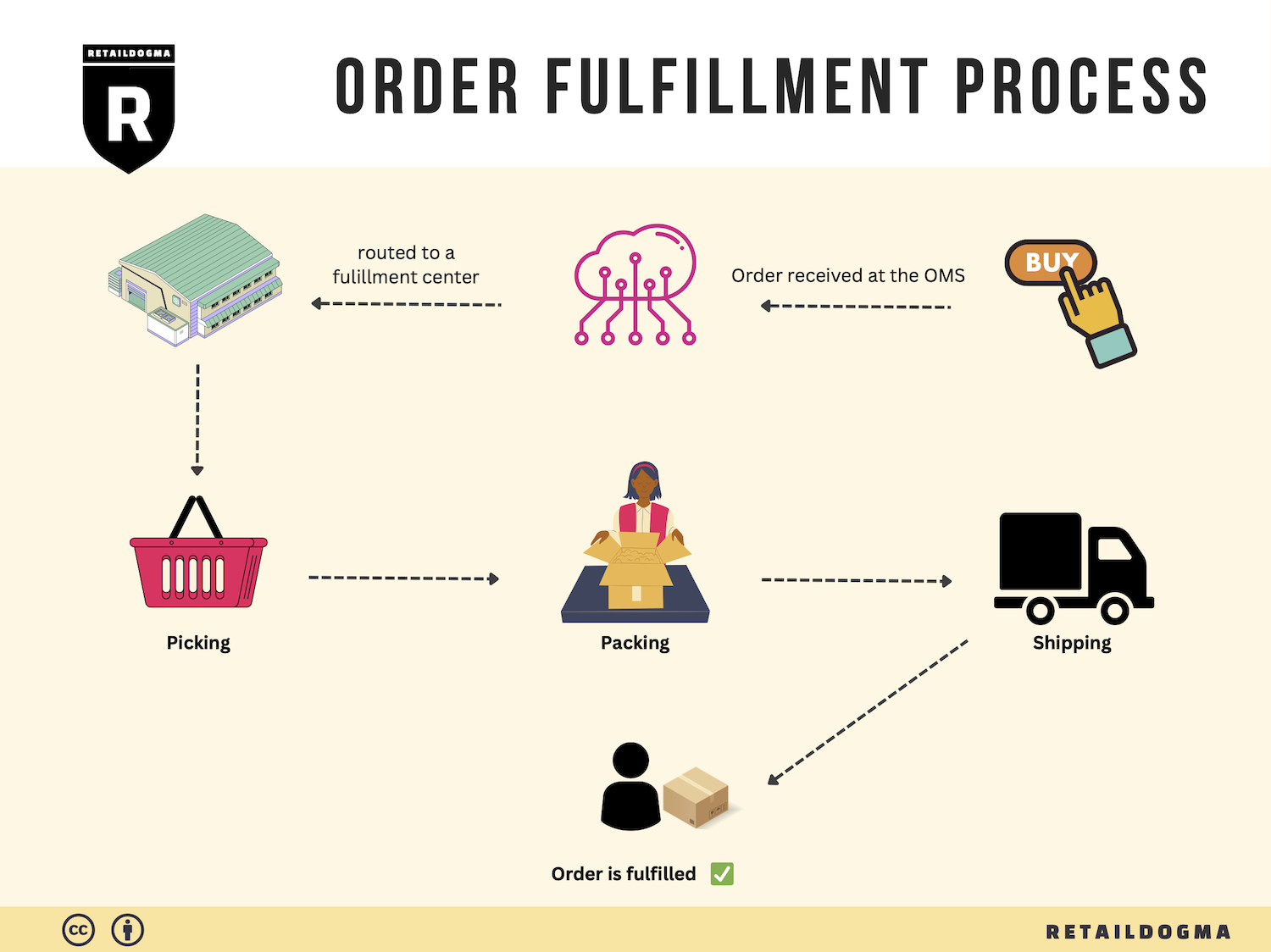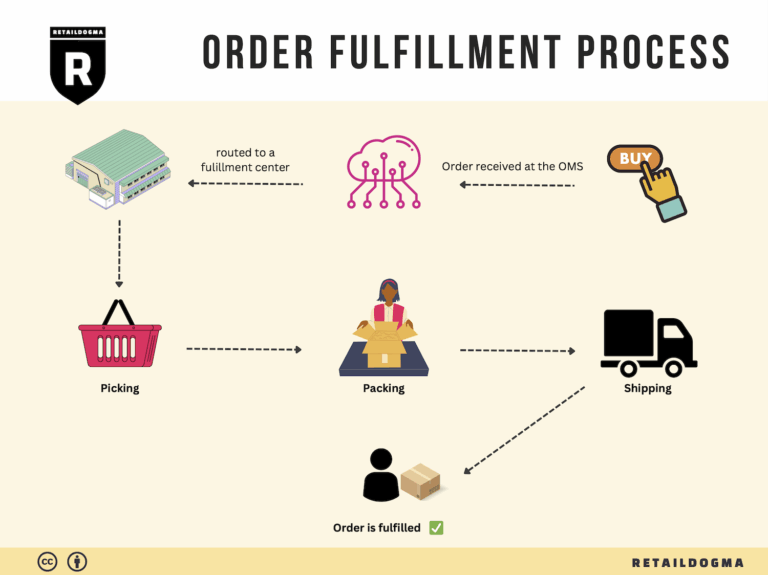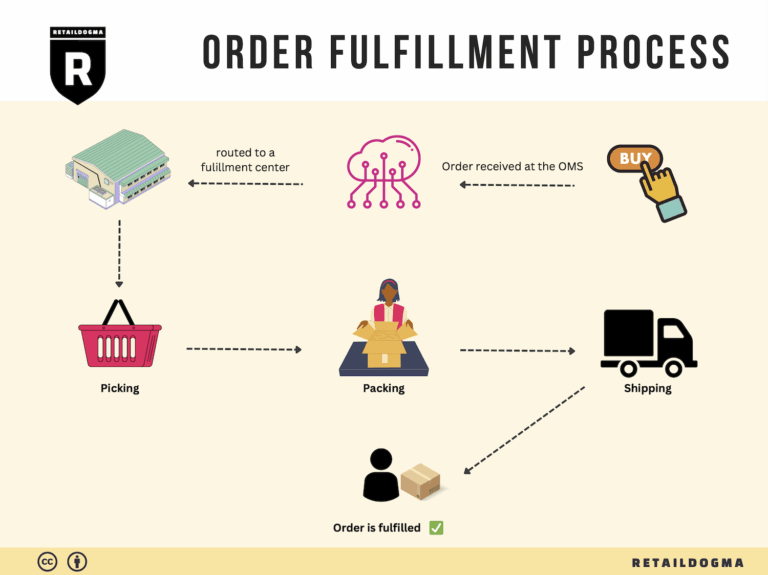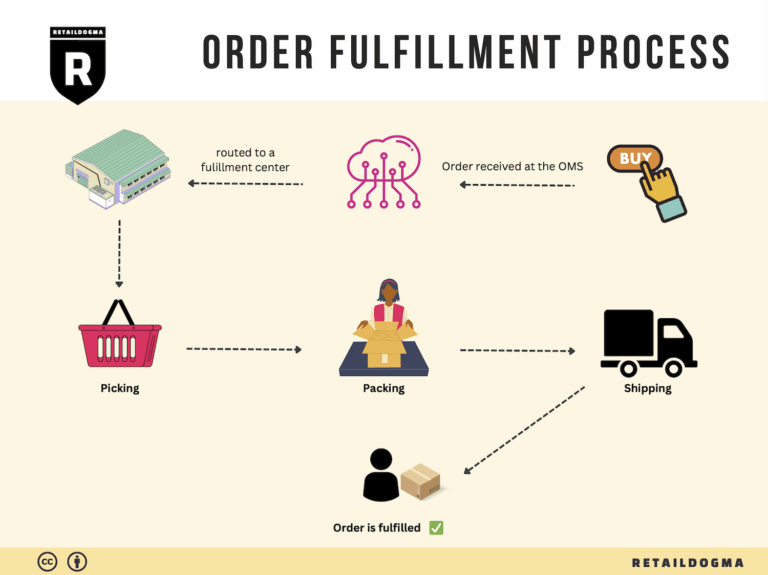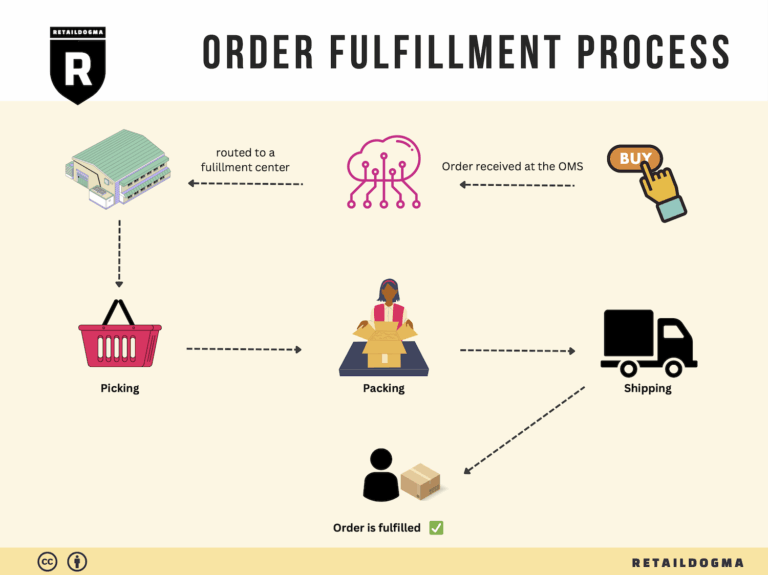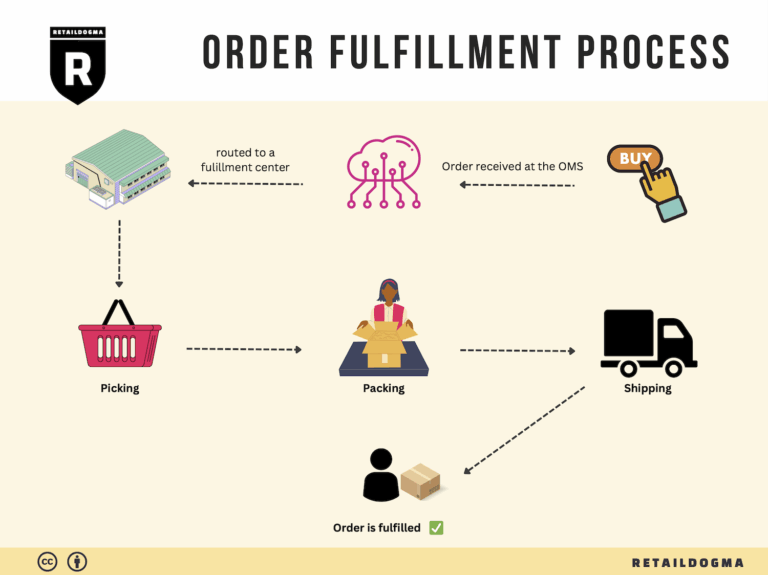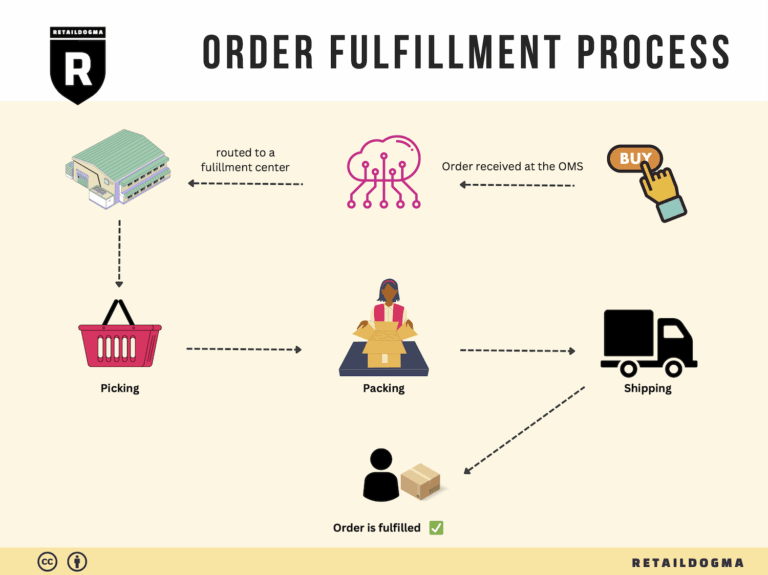What Is A Fulfillment Center? A Complete Guide (2025)
What is E-commerce Fulfillment? An Introduction for Growing Businesses
Understanding E-commerce Fulfillment
As an e-commerce business owner, you’ve likely experienced the stress of managing order fulfillment. The excitement of making sales can quickly turn into an overwhelming burden as you juggle the logistics of packing and shipping orders. This is a common pain point for growing online businesses, where the demands of fulfilling orders can detract from focusing on scaling and enhancing your product offerings.
So, what exactly is e-commerce fulfillment? Simply put, it’s the comprehensive process of getting a product from your warehouse to your customer’s doorstep. This involves several critical steps: receiving inventory, storing products, picking and packing orders, and finally, shipping them to the customers. The efficiency of this process can significantly impact customer satisfaction and your overall business success.
In this guide, we will explore the various fulfillment models available to e-commerce businesses, including third-party logistics (3PL) and Fulfillment by Amazon (FBA). Each model has its unique advantages and challenges, allowing you to choose one that aligns best with your business needs and growth trajectory.
We will also delve into the core services that fulfillment providers offer, such as inventory management, order processing, and return handling. Understanding these services will enable you to better evaluate potential partners and streamline your operations.
Selecting the right fulfillment partner can be daunting, but it’s crucial for your business’s scalability. This guide will outline key considerations to help you make an informed decision, including evaluating service quality, geographic reach, technology integration, and customer support.
Pricing is another essential aspect of e-commerce fulfillment that we will discuss. Understanding the cost structures associated with different fulfillment models will empower you to budget effectively and avoid unexpected expenses.
Ultimately, this guide aims to equip you with the knowledge and insights necessary to make smart logistics decisions for your growing business. By optimizing your e-commerce fulfillment strategy, you can enhance customer satisfaction, reduce operational stress, and position your business for sustainable growth.
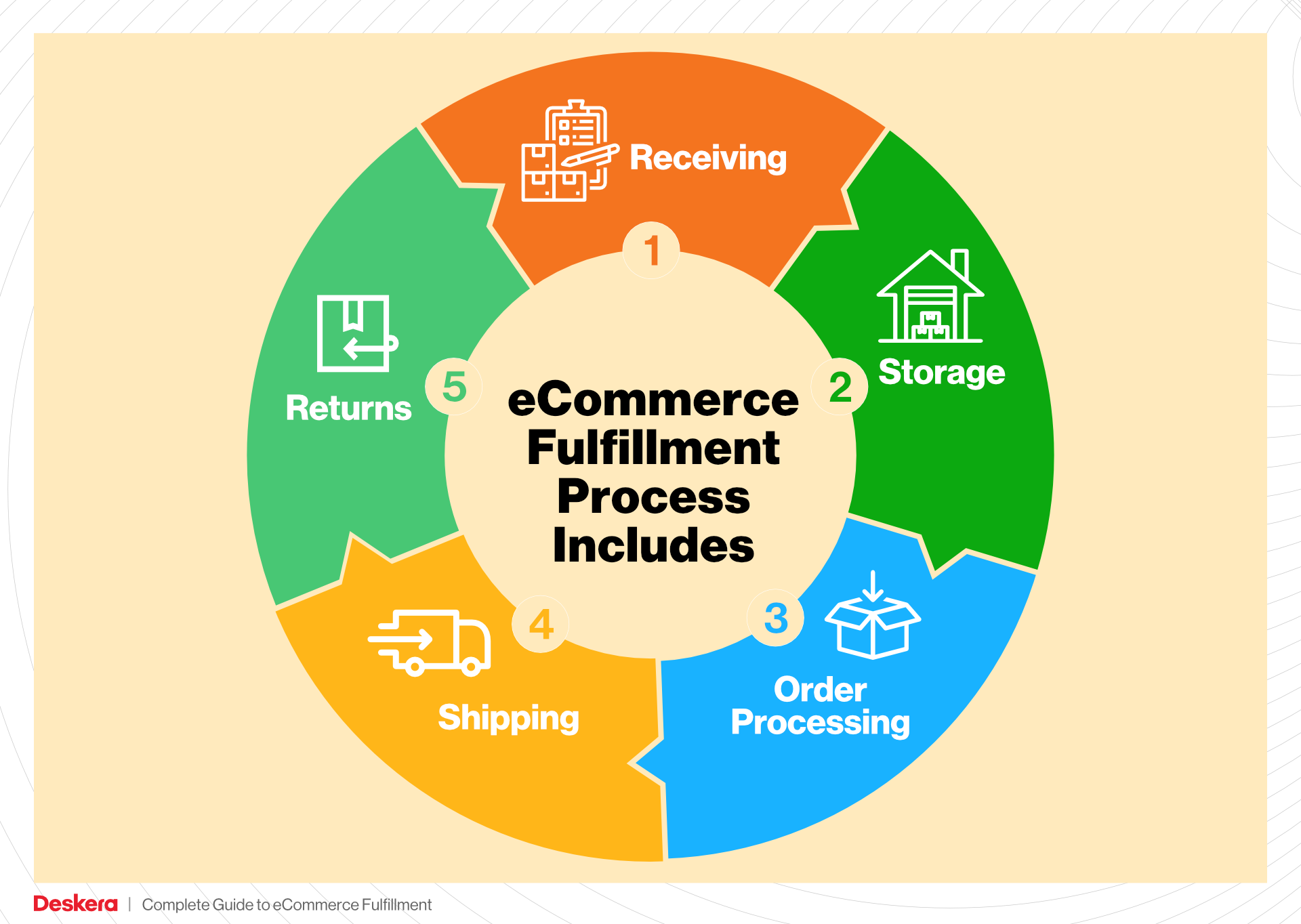
What You’ll Learn In This Guide
- What is E-commerce Fulfillment? An Introduction for Growing Businesses
- The Order Fulfillment Process: From ‘Buy’ Button to Customer’s Door
- Comparing Fulfillment Models: In-House vs. 3PL vs. Dropshipping
- A Deep Dive into Amazon FBA: Pros, Cons, and Who It’s For
- Core Services Offered by Fulfillment Centers
- How to Choose a Fulfillment Partner: A 6-Point Checklist
- Understanding Fulfillment Pricing: A Breakdown of Common Fees
- Frequently Asked Questions (FAQs) about Fulfillment
- Conclusion: Is Outsourcing Fulfillment the Right Move for Your Business?
- Important Disclaimer
The Order Fulfillment Process: From ‘Buy’ Button to Customer’s Door
1. Receiving Inventory
The first step in the order fulfillment process is receiving inventory from suppliers. This involves checking incoming shipments against purchase orders to ensure that the correct quantities and products have arrived. Businesses utilize Stock Keeping Units (SKUs) to identify and categorize products efficiently.
Why is this step important? Proper inventory receiving is crucial for maintaining accurate stock levels and preventing discrepancies that can lead to stockouts or overstock situations. This accuracy directly impacts customer satisfaction, as customers expect the products they order to be in stock and ready for shipping. Implementing a robust receiving process helps establish a solid foundation for the rest of the fulfillment cycle.
2. Warehouse Storage
Once inventory is received and accounted for, the next step is warehouse storage. Products are organized and stored in a manner that facilitates easy access and efficient order processing. This often involves classifying items based on their SKUs and using inventory management systems to track their locations within the warehouse.
The significance of effective warehouse storage cannot be overstated. An organized storage system minimizes the time spent locating items, thereby speeding up the order fulfillment process. Additionally, a well-structured warehouse layout can reduce handling costs and enhance the overall efficiency of the operation. Implementing a First-In-First-Out (FIFO) system can also help manage perishable goods and maintain product quality over time.
3. Order Picking
When a customer places an order, the next step is order picking. This involves retrieving the items from storage based on the customer’s order. Businesses often use pick lists, which are documents that outline the items needed for each order, including their locations within the warehouse.
Order picking is a critical phase in the fulfillment process as it directly influences shipping speed and accuracy. Efficient picking practices can lead to faster order fulfillment times, which is essential for meeting customer expectations. Various picking methods, such as batch picking or wave picking, can be employed depending on the order volume and warehouse layout. Automation tools and technologies, like RFID systems, can further enhance picking efficiency and accuracy.
4. Order Packing
After picking, the next step is order packing. This involves securely packaging the items for shipping, ensuring that they are protected during transit. Businesses typically use packing slips that detail the contents of each order, along with any necessary shipping labels.
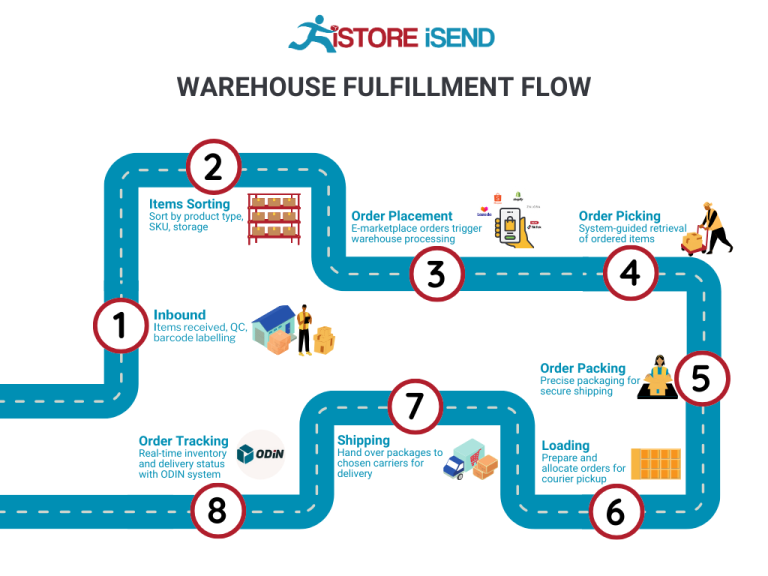
Packing is vital for several reasons. First, it ensures that products reach customers in perfect condition, which is key to maintaining brand reputation and customer loyalty. Second, well-packed orders can reduce shipping costs by optimizing box sizes and minimizing wasted space. Using appropriate packing materials also helps avoid damages and returns, ultimately saving costs in the long run. Companies should consider using eco-friendly packing materials as part of their sustainability efforts, which can also enhance customer perception.
5. Shipping & Delivery
The final step in the fulfillment process is shipping and delivery. This involves choosing the best shipping carriers and methods based on factors such as cost, speed, and destination. Businesses must also provide customers with tracking information to keep them informed about their order status.
Shipping and delivery are critical components of the customer experience. Fast and reliable shipping can significantly influence customer satisfaction and retention. Businesses should analyze shipping options regularly to find the most cost-effective solutions without compromising delivery speed. Additionally, understanding the logistics of international shipping, including customs and tariffs, is essential for businesses looking to expand their market reach.
In conclusion, an efficient order fulfillment process is essential for e-commerce success. By mastering each step—from receiving inventory to shipping and delivery—businesses can enhance operational efficiency, reduce costs, and ultimately improve customer satisfaction. Investing in the right technology and fulfillment solutions can further streamline these processes, allowing businesses to scale effectively.
Comparing Fulfillment Models: In-House vs. 3PL vs. Dropshipping
Fulfillment Model Comparison
| Model | Who Handles Inventory | Best For (Business Stage) | Key Advantage | Key Disadvantage |
|---|---|---|---|---|
| In-House Fulfillment | The e-commerce business | Startups, small businesses | Full control over the fulfillment process | Labor-intensive and potentially costly |
| Third-Party Logistics (3PL) | A third-party provider | Growing businesses | Scalability and reduced overhead | Less control over the fulfillment process |
| Dropshipping | Supplier or manufacturer | New or niche e-commerce businesses | Low upfront costs and risk | Limited control over inventory and delivery times |
In-House Fulfillment
In-house fulfillment is a model where e-commerce businesses manage the entire order fulfillment process within their own facilities. This includes handling inventory, packing orders, and shipping them directly to customers. This model is particularly suitable for startups and small businesses that have unique shipping requirements or wish to maintain a high level of control over their operations. The key advantage of in-house fulfillment is the ability to oversee every aspect of the order process, allowing for tailored customer experiences and potentially faster shipping times. However, this model can become labor-intensive and costly as the business scales. Managing a warehouse requires not only storage space but also staffing, technology for inventory management, and logistics expertise. As order volumes increase, many businesses find it challenging to keep up with demand, leading them to consider alternative fulfillment options.
Third-Party Logistics (3PL)
Third-party logistics (3PL) refers to outsourcing the fulfillment process to specialized service providers. These companies manage inventory storage, order processing, packing, and shipping on behalf of the e-commerce business. This model is ideal for growing businesses that have outgrown their in-house capabilities but are not yet ready to invest in their own fulfillment infrastructure. The primary advantage of using a 3PL is scalability; businesses can easily adjust their logistics operations according to fluctuating demand without incurring the fixed costs associated with maintaining their own warehouses. 3PL providers often have established relationships with shipping carriers, allowing them to negotiate lower shipping rates and providing faster delivery options. However, the key disadvantage is the loss of direct control over the fulfillment process. Businesses must rely on their 3PL partner to maintain quality standards, manage inventory levels accurately, and ensure timely shipping, which can lead to customer service challenges if the 3PL fails to meet expectations.
Dropshipping
Dropshipping is a fulfillment model where the e-commerce business does not keep products in stock. Instead, when a customer places an order, the business purchases the item from a third-party supplier who then ships it directly to the customer. This model is particularly attractive for new or niche e-commerce businesses, as it requires minimal upfront investment and eliminates the risks associated with holding inventory. The primary advantage of dropshipping is the low overhead costs; businesses do not need to invest in storage facilities or manage inventory, allowing them to focus on marketing and sales. However, dropshipping also comes with significant drawbacks. Businesses have limited control over inventory, which can lead to issues with stock availability and longer delivery times. Additionally, the reliance on suppliers for fulfillment can result in inconsistent product quality and shipping reliability, potentially harming the business’s reputation. As such, while dropshipping can be a low-risk entry point into e-commerce, it may not be sustainable for businesses looking to scale and provide superior customer service.
In summary, choosing the right fulfillment model depends on the unique needs, stage of growth, and long-term strategy of the business. Each model has its advantages and disadvantages, and business owners must weigh these factors carefully to select the best path forward as they scale their operations.
A Deep Dive into Amazon FBA: Pros, Cons, and Who It’s For
What is Fulfillment by Amazon (FBA)?
Fulfillment by Amazon (FBA) is a comprehensive fulfillment service that allows online sellers to store their products in Amazon’s fulfillment centers. When a customer orders a product, Amazon takes care of storage, packaging, and shipping, as well as handling customer service and returns. This service is particularly appealing to sellers who want to leverage Amazon’s vast logistics network and customer base without the overhead of managing their own warehousing and shipping operations.
To get started with FBA, sellers simply create an Amazon seller account, prepare their products according to Amazon’s guidelines, and ship their inventory to designated Amazon fulfillment centers. Once the inventory is received and processed, products become eligible for Amazon Prime and other Amazon services, which can significantly boost visibility and sales.
How FBA Works
-
Account Setup: Sellers create an Amazon seller account and choose FBA as their fulfillment option.
-
Product Preparation: Sellers prepare their products according to Amazon’s strict guidelines, which include labeling and packaging requirements.
-
Shipping to Amazon: Sellers send their inventory to Amazon’s fulfillment centers. Depending on the seller’s location and the products being shipped, Amazon may recommend specific centers to optimize shipping times and costs.
-
Storage: Once the products arrive, they are stored in Amazon’s warehouses until sold.
-
Order Fulfillment: When a customer places an order, Amazon picks, packs, and ships the product on behalf of the seller.
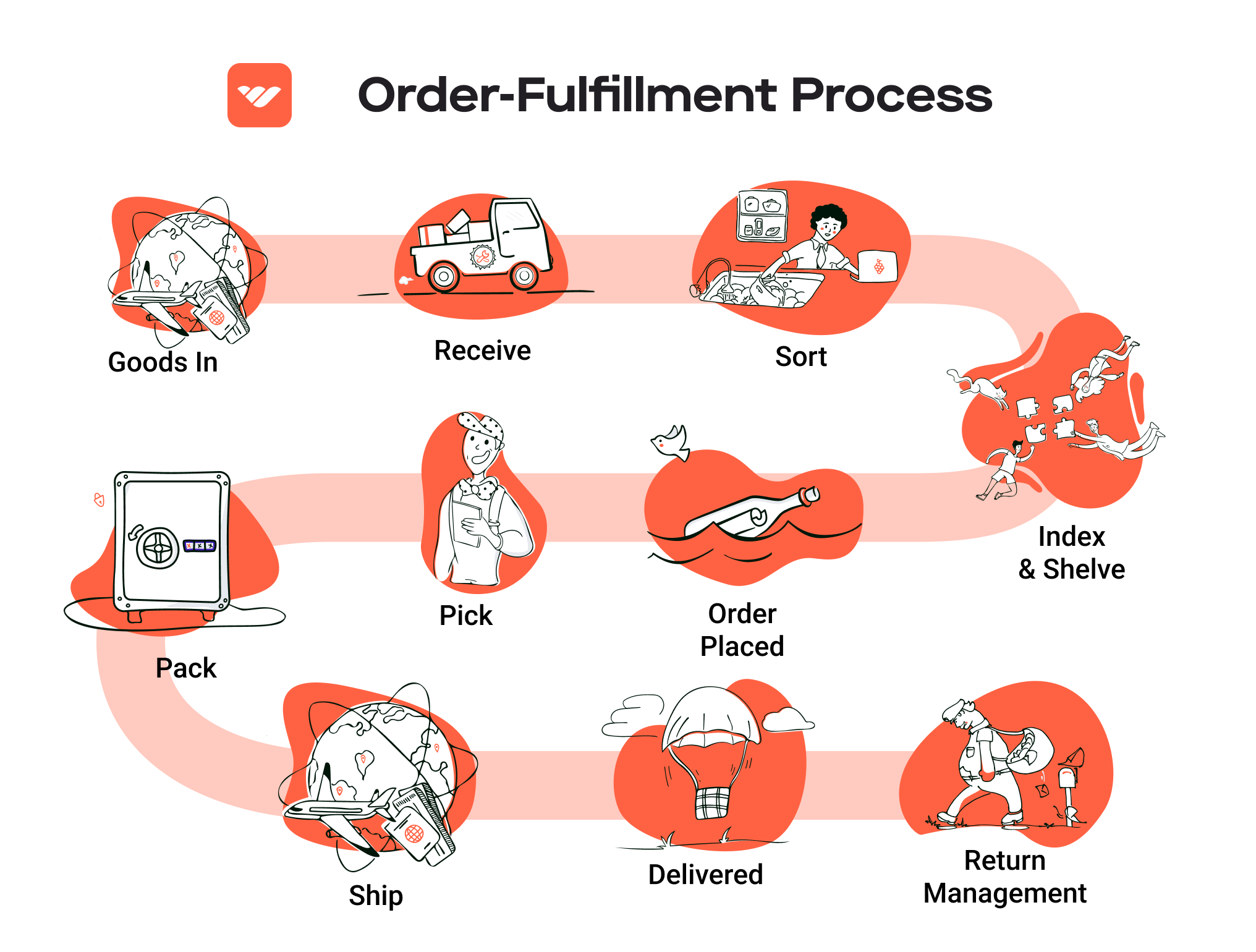
-
Customer Service: Amazon also manages customer inquiries and returns, providing sellers with a seamless experience.
-
Performance Tracking: Sellers have access to an inventory performance dashboard to monitor sales, track customer behavior, and manage their stock.
Pros of Using FBA
Prime Eligibility
One of the most significant advantages of using FBA is the eligibility for Amazon Prime. Products fulfilled by Amazon are often eligible for two-day shipping, which is a major draw for Prime members. This can lead to increased sales, as many consumers filter their searches to show only Prime-eligible products.
Customer Trust
Amazon has established a strong reputation for reliability and customer service. When sellers use FBA, they benefit from this trust, as customers are more likely to purchase items that are fulfilled by Amazon due to perceived quality and service standards.
Multi-Channel Fulfillment
FBA isn’t limited to just Amazon. Sellers can use FBA for multi-channel fulfillment, meaning they can sell their products on other platforms (like their own website or eBay) while still using Amazon’s logistics network. This flexibility allows sellers to reach a broader audience without the complexity of managing multiple fulfillment processes.
Streamlined Operations
By outsourcing fulfillment to Amazon, sellers can focus on other aspects of their business, such as marketing and product development. This can lead to more efficient operations and the ability to scale more rapidly.
Cons of Using FBA
High Fees
While FBA offers many benefits, it comes at a cost. Amazon charges storage fees for holding inventory, as well as fulfillment fees for each item sold. These fees can add up quickly, especially for sellers with lower-margin products, potentially eating into profits.
Strict Inventory Rules
Amazon has stringent inventory management policies that sellers must adhere to. This includes limitations on storage space, especially during peak seasons, and requirements for inventory performance metrics. Failure to meet these standards can result in additional fees or even account suspension.
Commingling Risks
One potential downside of FBA is the commingling of inventory. When products are stored in Amazon’s warehouses, they may be mixed with other sellers’ products. This can lead to issues such as counterfeit concerns or problems with returns, as it may be difficult to ensure that customers receive the correct item.
Limited Control Over Fulfillment
When using FBA, sellers relinquish control over the fulfillment process. This can lead to complications if there are issues with shipping times, inventory accuracy, or customer service. Sellers must rely on Amazon’s systems and processes, which may not always align with their business needs.
Who is FBA Best For?
FBA is ideally suited for:
-
Established Sellers: Businesses that already have a steady stream of sales and are looking to scale efficiently can benefit significantly from FBA’s logistics capabilities.
-
High-Volume Sellers: Sellers with a large volume of orders can leverage Amazon’s network to manage fulfillment at scale, reducing the complexity of logistics.
-
Sellers with Low-Margin Products: For products that are relatively inexpensive, the ability to offer Prime shipping and the trust associated with Amazon can help drive sales that might not be achievable through other channels.
-
Brands Looking to Expand Reach: Businesses aiming to broaden their market presence can use FBA to tap into Amazon’s extensive customer base while maintaining their own brand identity through multi-channel selling.
-
New Sellers: Entrepreneurs just starting out can benefit from the ease of use and rapid setup of FBA, allowing them to focus on marketing and sales rather than logistics.
In conclusion, Fulfillment by Amazon (FBA) offers a powerful solution for e-commerce sellers looking to streamline their operations, reach a broader audience, and leverage Amazon’s extensive logistics network. However, it is essential to weigh the benefits against the costs and challenges to determine if it aligns with your business goals.
Core Services Offered by Fulfillment Centers
Inventory Management & Warehousing
Inventory management and warehousing are fundamental services provided by fulfillment centers that help e-commerce businesses maintain optimal stock levels and storage solutions. Effective inventory management involves tracking stock levels, sales patterns, and reorder points to ensure that businesses have the right amount of product available at the right time.
Fulfillment centers utilize advanced software systems to monitor inventory in real-time, allowing e-commerce businesses to make informed decisions about stock replenishment and avoid overstocking or stockouts. This service also includes strategic warehousing solutions, where fulfillment centers are often located near major transportation hubs to facilitate faster shipping times.
Benefits:
– Cost Efficiency: By outsourcing inventory management and warehousing, e-commerce businesses can save on overhead costs associated with maintaining their own facilities and staff.
– Improved Cash Flow: Efficient inventory management prevents capital from being tied up in unsold stock, allowing businesses to invest in growth initiatives.
– Scalability: As demand fluctuates, fulfillment centers can easily adjust storage space and inventory levels, enabling businesses to scale operations without significant investment.
Pick and Pack Services
Pick and pack services are integral to the order fulfillment process, where fulfillment centers handle the picking of items from inventory and packing them for shipment. When an order is received, fulfillment staff quickly locate the ordered products, assemble them, and prepare them for shipping. This service often employs automated systems to enhance accuracy and speed, ensuring that orders are filled correctly.
Benefits:
– Speed: Efficient pick and pack processes reduce the time between order receipt and shipment, enhancing customer satisfaction through faster delivery times.
– Accuracy: Fulfillment centers invest in technology that minimizes human error, ensuring that the right products are packed and shipped to customers.
– Focus on Core Activities: By outsourcing these tasks, e-commerce businesses can concentrate on other critical areas such as marketing, product development, and customer service.
Kitting and Assembly
Kitting and assembly services provided by fulfillment centers involve combining multiple products into a single package or kit, ready for sale. This is particularly useful for businesses that sell bundled products or require assembly before shipping. For example, a fulfillment center can assemble a gift basket or package a set of components for a DIY project.
Benefits:
– Enhanced Product Offerings: Kitting allows e-commerce businesses to create unique product offerings, which can increase average order value and attract more customers.
– Reduced Shipping Costs: By combining items into a single package, businesses can reduce shipping costs and improve the overall customer experience.
– Streamlined Operations: Outsourcing kitting and assembly tasks means that businesses do not need to invest in the necessary labor and equipment, allowing for a more streamlined operation.
Returns Management (Reverse Logistics)
Returns management, also known as reverse logistics, is a critical service that fulfillment centers provide to handle product returns efficiently. This process includes receiving returned items, inspecting them for damages, restocking them if they are in sellable condition, or processing them for disposal or recycling.
A robust returns management system is essential for e-commerce businesses, as customers increasingly expect hassle-free returns. Fulfillment centers can streamline this process by providing clear instructions for returns and managing the logistics involved.
Benefits:
– Customer Satisfaction: Efficient returns management enhances customer satisfaction and loyalty by providing a seamless return experience, which can be a deciding factor in repeat purchases.
– Cost Management: By handling returns in an organized manner, fulfillment centers can help businesses minimize losses associated with returned goods and reduce storage costs for unsold inventory.
– Data Insights: Analyzing return patterns can provide valuable insights into product quality and customer preferences, enabling businesses to make informed decisions about product offerings and improvements.
By leveraging these core services, e-commerce businesses can optimize their fulfillment processes, improve customer satisfaction, and ultimately scale their operations effectively. Partnering with a fulfillment center allows businesses to focus on growth and innovation while ensuring that the logistics of order fulfillment are handled professionally and efficiently.
How to Choose a Fulfillment Partner: A 6-Point Checklist
Location & Warehouse Network
Why It Matters: The geographic location of your fulfillment partner’s warehouses plays a crucial role in shipping speed and costs. A partner with strategically placed warehouses can reduce shipping times and expenses by bringing products closer to your customers.
Questions to Ask:
– How many fulfillment centers do you operate, and where are they located?
– Can you provide shipping coverage maps to illustrate delivery times to key markets?
– Do you offer options for international fulfillment if needed?
Technology & Integrations
Why It Matters: A fulfillment partner’s technology capabilities can significantly impact the efficiency of your operations. Robust systems facilitate real-time inventory tracking, order management, and integration with your e-commerce platform.
Questions to Ask:
– What technology platforms do you use for order management, inventory tracking, and customer communications?
– Can your system integrate seamlessly with my existing e-commerce platform (e.g., Shopify, WooCommerce)?
– Do you provide API access for custom integrations if needed?
Specializations (e.g., Cold Storage, Oversized Items)
Why It Matters: Not all fulfillment partners are equipped to handle every type of product. If your business involves specialized items—like perishables requiring cold storage or oversized items—it’s essential to choose a partner with the necessary capabilities.
Questions to Ask:
– Do you have experience handling my specific product types (e.g., temperature-sensitive items, large or heavy products)?
– What specialized equipment or facilities do you have to accommodate these needs?
– Can you share case studies or references from similar businesses that you have serviced?
Scalability & Capacity
Why It Matters: As your business grows, your fulfillment needs will change. A suitable partner should have the capacity to scale with you, ensuring that they can handle increased order volumes without compromising service quality.
Questions to Ask:
– How do you manage peak seasons, such as holidays or sales events?
– What processes do you have in place to ensure you can scale operations quickly when needed?
– Can you provide metrics or data on how you have supported other clients during their growth phases?
Pricing and Contracts
Why It Matters: Understanding the pricing structure and contract terms is vital to avoid unexpected costs that can impact your bottom line. Transparent pricing models help you budget effectively and assess the total cost of fulfillment.
Questions to Ask:
– Can you provide a detailed breakdown of your pricing structure (e.g., storage fees, shipping costs, handling fees)?
– Are there any additional fees for services like returns processing, packaging, or special handling?
– What are the terms for contract termination or renewal, and is there flexibility in your agreements?
Customer Support & Reviews
Why It Matters: Reliable customer support can make a significant difference in resolving issues quickly and maintaining a smooth operation. Additionally, reviews and testimonials from existing clients can provide insight into the partner’s reliability and service quality.
Questions to Ask:
– What customer support channels do you offer (e.g., phone, email, chat), and what are your response times?
– Can you share references or case studies from current or previous clients?
– How do you handle issues or complaints, and what is your process for resolving them?
Conclusion
Choosing the right fulfillment partner is a critical step in scaling your e-commerce business. By considering these six essential factors—location and warehouse network, technology and integrations, specializations, scalability, pricing, and customer support—you can make a well-informed decision that aligns with your operational needs and growth objectives. Take the time to ask the right questions and assess potential partners carefully, as a strong fulfillment relationship can significantly enhance your customer experience and overall business success.
Understanding Fulfillment Pricing: A Breakdown of Common Fees
Initial Setup Fees
When partnering with a fulfillment service, businesses often encounter initial setup fees. These fees cover the costs associated with onboarding your account, including software configuration, system integrations, and initial inventory setup. The amount can vary significantly based on the complexity of your operations and the fulfillment provider you choose. Some companies might charge a flat fee, while others may base it on the number of products or SKU (Stock Keeping Unit) you wish to integrate into their system.
To minimize these costs, it is advisable to clearly outline your needs and ask for detailed breakdowns from potential providers. Look for fulfillment partners that offer transparent pricing structures and consider negotiating on these fees, especially if you plan to commit to a long-term partnership.
Receiving Fees
Receiving fees are charged when your inventory arrives at the fulfillment center. These fees typically cover the process of unloading, inspecting, and stocking your products. The cost can depend on various factors, such as the volume of inventory, the number of SKUs, and whether the items require special handling (e.g., fragile goods).
Receiving fees are usually calculated per pallet or per hour of labor required for unloading and processing. It’s beneficial to clarify these charges upfront and understand how they might scale with your inventory levels. Some fulfillment centers may offer discounts for bulk shipments, so consider consolidating shipments to take advantage of these savings.
Storage Fees (per pallet/bin)
Storage fees apply to the space your inventory occupies within the fulfillment center. These fees can be calculated on a per-pallet or per-bin basis, with costs varying based on the location of the warehouse and the demand for storage space. Many fulfillment providers charge monthly storage fees, which can be tiered based on the amount of inventory you store.
To manage these costs effectively, it’s crucial to monitor your inventory levels and maintain an optimal stock level. Excess inventory can lead to higher storage fees, while understocking can affect your fulfillment speed. Some providers may also offer long-term storage discounts or free storage for certain promotional periods, so inquire about these options.
Pick & Pack Fees (per item/order)
Pick and pack fees are incurred when your orders are processed. This includes picking the products from the shelves, packing them appropriately, and preparing them for shipment. These fees are typically charged per item or per order, and they can vary based on the complexity of the packaging (e.g., custom packaging may incur additional fees).
Understanding how these fees are structured is vital for budgeting your fulfillment costs. Some fulfillment centers offer tiered pricing, where the more items you ship, the lower the per-item fee becomes. It’s wise to analyze your order patterns and negotiate with providers to ensure you’re getting the best possible rates.
Shipping Fees
Shipping fees are one of the most significant costs associated with fulfillment services. These fees cover the transportation of your products to the customer and can vary based on several factors, including the shipping method (standard, expedited, etc.), the destination, and the weight and dimensions of the package.
Fulfillment providers often have negotiated rates with carriers, which can help lower your shipping costs. It’s essential to understand how these fees are calculated and to compare rates from different fulfillment partners. Additionally, consider the impact of shipping times on customer satisfaction; faster shipping may come at a premium, but it can lead to higher conversion rates and repeat business.
Tips for Getting an Accurate Quote
-
Provide Detailed Information: When requesting quotes, be as detailed as possible about your product types, volume, and shipping frequency. This information will help fulfillment providers give you a more accurate estimate.
-
Ask for a Breakdown of Fees: Request a detailed breakdown of all fees, including hidden costs that might arise. Understanding every component of the pricing structure is crucial for budgeting.
-
Negotiate: Don’t hesitate to negotiate on fees, especially if you have a long-term business plan that includes increasing order volumes.
-
Consider Seasonal Variations: If your business experiences seasonal peaks, ensure that your quote reflects those fluctuations in demand, as this may affect storage and shipping fees.
-
Review Contracts Carefully: Before signing any agreement, review the terms and conditions regarding pricing, including any potential increases or additional fees that could arise over time.
By following these guidelines, you can navigate the complexities of fulfillment pricing and find a solution that aligns with your business goals.
Frequently Asked Questions (FAQs) about Fulfillment
1. What is eCommerce fulfillment?
Ecommerce fulfillment is the process of receiving, processing, and delivering orders to customers. It encompasses inventory management, order processing, packing, and shipping. Effective fulfillment ensures that products reach customers quickly and efficiently, enhancing their shopping experience.
2. What’s the difference between a warehouse and a fulfillment center?
A warehouse is primarily a storage facility for inventory, while a fulfillment center is designed specifically to pick, pack, and ship products to customers. Fulfillment centers focus on order processing and logistics, ensuring faster delivery times and streamlined operations.
3. What is a 3PL (Third-Party Logistics)?
A 3PL, or Third-Party Logistics provider, is a company that offers outsourced logistics services, including warehousing, inventory management, and order fulfillment. Businesses partner with 3PLs to reduce operational costs, scale their logistics, and improve delivery speeds without managing these processes in-house.
4. How much do fulfillment services cost?
Fulfillment service costs vary based on factors such as order volume, storage needs, shipping methods, and the specific services offered. Generally, costs may include storage fees (often calculated per cubic foot), picking and packing fees (per order), and shipping charges. It’s essential to request quotes from multiple providers to compare pricing effectively.
5. How do I choose the right fulfillment service for my business?
To choose the right fulfillment service, consider factors such as your order volume, product types, target markets, and budget. Evaluate providers based on their shipping speeds, technology integrations, customer service, and reliability. Reading customer reviews and seeking recommendations can also guide your decision.
6. What fulfillment methods are available?
The main fulfillment methods include self-fulfillment, where businesses handle their own orders; third-party fulfillment, where a partner manages storage and shipping; and dropshipping, where a retailer forwards orders to a supplier who ships directly to the customer. Each method has its pros and cons depending on your business model.
7. How can I track my fulfillment orders?
Most fulfillment services provide tracking capabilities through their platforms. After an order is processed, tracking information is typically generated and sent to the merchant, allowing them to monitor the shipment’s progress. Integrating your eCommerce platform with your fulfillment provider can streamline this process.
8. What are the benefits of using a fulfillment service?
Using a fulfillment service can save time and reduce operational complexities, allowing businesses to focus on growth. Key benefits include faster shipping times, reduced shipping costs through bulk rates, improved inventory management, and access to advanced technology for order processing and tracking.
9. Can fulfillment services handle returns?
Yes, many fulfillment services offer return management as part of their operations. They can process returns, restock items, and manage customer exchanges, which helps maintain customer satisfaction and streamline the returns process for businesses.
10. How does international shipping work with fulfillment services?
International shipping through fulfillment services involves additional considerations, such as customs clearance, tariffs, and international shipping rates. Many fulfillment providers specialize in cross-border logistics and can help navigate these complexities, ensuring that products reach international customers efficiently and in compliance with local regulations.
Conclusion: Is Outsourcing Fulfillment the Right Move for Your Business?
Evaluating the Benefits of Outsourcing Fulfillment
Outsourcing your fulfillment can be a transformative decision for your e-commerce business, offering significant advantages that can pave the way for sustainable growth. One of the most compelling benefits is the time savings; by entrusting order processing, packing, and shipping to a specialized provider, you free up valuable resources to focus on strategic initiatives like marketing, product development, and customer engagement. This shift can enhance your operational efficiency and allow you to respond more swiftly to market demands.
Scalability is another critical benefit of utilizing fulfillment services. As your business grows, so do the complexities of managing inventory and shipping logistics. A reliable fulfillment partner can seamlessly scale operations to meet increasing order volumes without the need for significant capital investment in warehouse space or staff. This flexibility ensures that you can focus on expanding your market reach without getting bogged down by logistical challenges.
Additionally, partnering with a fulfillment service brings expertise to the table. These providers are specialists in logistics and inventory management, often employing advanced technologies and best practices that can enhance your operational performance. Their experience in navigating shipping regulations, optimizing delivery routes, and managing returns can lead to better customer satisfaction and retention.
However, it’s crucial to choose the right fulfillment partner. Conducting thorough research and due diligence is essential to ensure that your chosen provider aligns with your business goals and can support your growth trajectory.
Take Action
Now is the time to evaluate your current shipping and fulfillment processes. Are they efficient and scalable? Consider conducting an audit of your operations to identify bottlenecks and areas for improvement. If you find that fulfillment is consuming too much of your time and resources, it may be time to explore outsourcing options. By taking this step, you can position your business for accelerated growth and enhanced customer satisfaction.
Important Disclaimer
⚠️ Important Disclaimer
The information in this guide is for educational purposes. Fulfillment services, pricing, and platform features change frequently. Always conduct your own due diligence and consult with providers directly before making business decisions.
